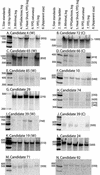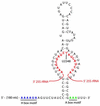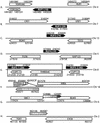Computational identification of non-coding RNAs in Saccharomyces cerevisiae by comparative genomics
- PMID: 12853629
- PMCID: PMC165953
- DOI: 10.1093/nar/gkg438
Computational identification of non-coding RNAs in Saccharomyces cerevisiae by comparative genomics
Abstract
We screened for new structural non-coding RNAs (ncRNAs) in the genome sequence of the yeast Saccharomyces cerevisiae using computational comparative analysis of genome sequences from five related species of Saccharomyces. The screen identified 92 candidate ncRNA genes. Thirteen showed discrete transcripts when assayed by northern blot. Of these, eight appear to be novel ncRNAs ranging in size from 268 to 775 nt, including three new H/ACA box small nucleolar RNAs.
Figures




References
-
- Eddy S.R. (2001) Non-coding RNA genes and the modern RNA world. Nature Rev. Genet., 2, 919–929. - PubMed
-
- Storz G. (2002) An expanding universe of noncoding RNAs. Science, 296, 1260–1263. - PubMed
-
- Kiss T. (2002) Small nucleolar RNAs: an abundant group of noncoding RNAs with diverse cellular functions. Cell, 109, 145–148. - PubMed
-
- Pasquinelli A.E. and Ruvkun,G. (2002) Control and developmental timing by microRNAs and their targets. Annu. Rev. Cell. Dev. Biol., 18, 495–513. - PubMed
-
- Rivas E., Klein,R.J., Jones,T.A. and Eddy,S.R. (2001) Computational identification of noncoding RNAs in E. coli by comparative genomics. Curr. Biol., 11, 1369–1373. - PubMed
Publication types
MeSH terms
Substances
Associated data
- Actions
- Actions
- Actions
- Actions
- Actions
Grants and funding
LinkOut - more resources
Full Text Sources
Other Literature Sources
Molecular Biology Databases
Research Materials

